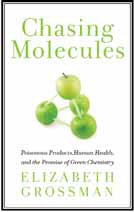SEJournal Online is the digital news magazine of the Society of Environmental Journalists. Learn more about SEJournal Online, including submission, subscription and advertising information.

BookShelf
Chasing Molecules: Poisonous Products, Human Health, and the Promise of Green Chemistry
By Elizabeth Grossman
Island Press, $26.96
Reviewed by MADELINE BODIN
In 1929, there was no such thing as a plastic bag. Synthetic materials were made from cellulose, corn, milk, alcohol and starch. Cellophane, made from cellulose, was a big deal. It was thin, flexible and water resistant. Still, it wasn’t perfect. For example, it wasn’t waterproof.
In the 1930s and 1940s, researchers developed formulas for polyvinyl chlorides, or PVCs, to create waterproof, flexible, malleable and strong products. It was a revolution in materials science and culture and there was no turning back. But while we have all benefited, writes Elizabeth Grossman in Chasing Molecules: Poisonous Products, Human Health, and the Promise of Green Chemistry, we also have paid a price.
In Chasing Molecules, Grossman details the problems a new generation of synthetic materials, mostly derived from petroleum, created for human health. Her book offers a lively primer on the toxic compounds in consumer goods. That may be why Booklist, a magazine of the American Library Association, named it one of the top 10 Sci/Tech books of 2009.
Grossman examines five toxics with full-chapter treatments that discuss everything from their development and harmful health effects to the efforts to produce benign materials to replace them. Grossman chases toxics literally to the ends of the earth, describing scientific expeditions to the Arctic that found high concentrations of compounds far from where they were manufactured and used. “Anything released in the mid-latitudes travels rapidly north,” one researcher tells her. In other words, the Arctic is the final resting place for the contaminants generated in most of the developed world.
For decades, these contaminants traveled north on wind and water until they became trapped in Arctic ice. Grossman points out that the melting of Arctic ice releases the contaminants back into the environment. The contaminants include not only the toxic materials that vex us today, such as brominated flame retardants, but also substances like DDT, PCBs, and dioxins whose risks we thought we had put behind us.
Some products can be reformulated to reduce the risk. Grossman mentions formaldehyde-free plywood that uses a glue mimicking the substance mollusks use to cling to rocks. But she is skeptical of some chemical formulations billed as greener or better for human health. For example, she points out that the new, hard plastic that has replaced the bisphenol A formulation in water bottles hasn’t been subjected to the same tests that revealed the long-term risks of bisphenol A in the first place.
She points out that more than 82,000 synthetic materials are registered for commerce in the United States today. But she prevents any of this from becoming paralyzingly frightening by salting her explorations of harmful synthetics with “the promise of green chemistry.” In the final chapters, she profiles green chemists working on non-hazardous products. They insist that green chemistry is a set of principles, not a set of standards like LEED for green building or the USDA’s organic food criteria.
Grossman’s optimism enables her to investigate the darkest corners of our consumer economy and remain not just unshaken but hopeful for the future. Simply banning hazardous materials is too slow if done one compound at a time, she writes. Also, a ban doesn’t take into account the entire life cycle of a synthetic material, from its design to wherever it finally winds up. The answer, Grossman says, is openness. Today, many of the compounds used in consumer products are kept secret. Consumers who are told what things are made of, and what toxics are generated in their manufacture, will demand safer, greener products and drive toxic products out of the marketplace, she writes.
Madeline Bodin is a freelance journalist based in southern Vermont. She specializes in writing about the science of wildlife conservation and has also written about technology, waste, and alternative energy.
* From the quarterly newsletter SEJournal, Winter 2010-11 issue.












 Advertisement
Advertisement 



